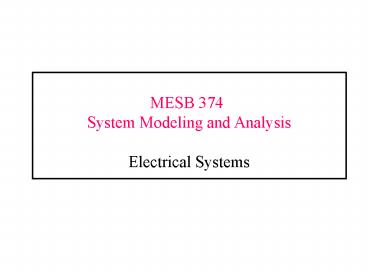ME375 Dynamic System Modeling and Control - PowerPoint PPT Presentation
1 / 12
Title:
ME375 Dynamic System Modeling and Control
Description:
Energy supplied is stored in its electric field and can affect future circuit response. ... Draw Simplified Schematics Using Basic Elements. Develop Mathematical Model ... – PowerPoint PPT presentation
Number of Views:88
Avg rating:3.0/5.0
Title: ME375 Dynamic System Modeling and Control
1
MESB 374 System Modeling and
AnalysisElectrical Systems
2
Electrical Systems
- Basic Modeling Elements
- Interconnection Relationships
- Derive Input/Output Models
3
Variables
- q charge C (Coulomb)
- i current A
- e voltage V
- R resistance W
- C capacitance Farad
- L inductance H (Henry)
- p power Watt
- w work ( energy ) J
- 1 J (Joule) 1 V-A-sec
4
Basic Modeling Elements
- Capacitor
- Charge collected is proportional to the voltage
across. - Current is proportional to the rate of change of
the voltage across. - Energy supplied is stored in its electric field
and can affect future circuit response. - Steady-state response i0, Open Circuit
- Resistor
- Ohms Law
- Voltage across is proportional to the through
current. - Dissipates energy through heat.
- Analogous to friction elements in mechanical
systems, e.g. dampers
2
1
2
1
Static relation
dynamic relation
5
Basic Modeling Elements
- Inductor
- Voltage across is proportional to the rate of the
change of the through current. - Energy supplied is stored in its magnetic field.
- Steady-state response e0, Short Circuit
- Voltage Source
- Maintain specified voltage across two points,
regardless of the required current. - Current Source
- Maintain specified current, regardless of the
required voltage.
1
2
dynamic relation
1
2
Static relation
2
1
i(t)
6
Complex impedance Z(s)
Ratio of E(s), the Laplace transform (LP) of
voltage across the terminal, to I(s), the
Laplace transform (LP) of current through the
element, under the assumption of zero initial
conditions
Complex impedances of resistor, capacitor,
inductor are
7
Interconnection Laws
- Kirchhoff's Voltage Law (loop law)
- The total voltage drop along any closed loop in
the circuit is zero.
- Kirchhoffs Current Law (node law)
- The algebraic sum of the currents at any node in
the circuit is zero.
2
1
3
-
4
8
Series and Parallel Elements
- Parallel combinations
- Series combinations
- Equivalent Complex Impedance
9
Modeling Steps
- Understand System Function and Identify
Input/Output Variables - Draw Simplified Schematics Using Basic Elements
- Develop Mathematical Model
- Label Each Element and the Corresponding
Voltages. - Label Each Node and the Corresponding Currents.
- Apply Interconnection Laws.
- Check that the Number of Unknown Variables equals
the Number of Equations - Eliminate Intermediate Variables to Obtain
Standard Forms.
10
In Class Exercise
- No. of Unknowns
- Derive the I/O model for the following circuit.
Let voltage ei(t) be the input and the voltage
across the capacitor be the output.
Simplify
1
3
2
I/O Model
How to get I/O model by concept of complex
impedance ?
4
Element Laws
Mechanical translational system
Mechanical rotational system
Kirchhoffs Loop Law
11
Example
- Obtain the I/O model for the following circuit.
The input is the voltage ei(t) of the voltage
source and the through current of the inductor is
the output.
- Voltage Law
- Current Law
- Unknown Variables
- I/O Model
Loop 1
Loop 2
2
1
3
i1
2
Node 2
Loop 1
i3
Loop 2
4
Elemental Equations
12
Example (cont.)

